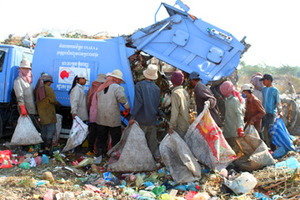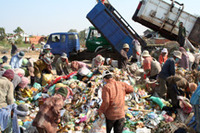by Andrea Gross; photos by Irv Green
I'm standing in Stung Meanchy, Cambodia's largest garbage dump. The stench is overwhelming, the grit from burned ash covers every inch of my body, and I'm wondering if I made a mistake by forcing everyone in our group to come here.
 After all, we'd seen plenty of poverty just driving around the streets of Phnom Penh. We'd even visited the killing fields, where we saw a stupa filled with skulls, a reminder of the more than 200,000 people who were murdered by the Khmer Rouge just thirty years ago. We knew the country was desperately poor, that the people were still too traumatized to rebuild their society.
After all, we'd seen plenty of poverty just driving around the streets of Phnom Penh. We'd even visited the killing fields, where we saw a stupa filled with skulls, a reminder of the more than 200,000 people who were murdered by the Khmer Rouge just thirty years ago. We knew the country was desperately poor, that the people were still too traumatized to rebuild their society.
Did we really need to tour a slum?
But I persisted. Why? Because friends of mine had started a project to rescue children from these slums. I’d seen their photos of Stung Meanchy, and I’d had a hard time believing the horror they depicted.
Now I realize that photographs can’t possibly convey the reality before me. They can’t reproduce the smell of rotting garbage and dead animals; they can’t convey feel of the gravelly particles that swirl around me, making their way, with every breath I take, into my nose, my mouth, my lungs.
Our bus driver hands me a mask. In theory, this will protect me from... from what? I'm afraid to ask. And as I look at the people around me — maskless in the putrid air — I'm embarrassed to put it on.
Men and women — most of whom look very old, although they're probably not — are sorting through the rubble in hopes of finding pieces of plastic or metal that they can sell. On a good day, they earn the equivalent of 50 cents. There aren't a lot of good days.
I take a few tentative steps and see a pile of discarded needles. I pray I won't step on one, pray that the barefoot children who are staring at me won't step on one either. But of course they will. If not today, tomorrow or the next day. This is, after all, the place where used hypodermics come to rest.
 A garbage truck rumbles up, and the mood in the dump changes, becomes electric. Like a cresting wave, the adults run, limp or hobble towards the truck, where they wait with thin arms outstretched to catch the latest batch of spoiled food and discarded goods. Maybe, just maybe, they'll find a treasure — or at least a tattered T-shirt that will offer protection from the sun.
A garbage truck rumbles up, and the mood in the dump changes, becomes electric. Like a cresting wave, the adults run, limp or hobble towards the truck, where they wait with thin arms outstretched to catch the latest batch of spoiled food and discarded goods. Maybe, just maybe, they'll find a treasure — or at least a tattered T-shirt that will offer protection from the sun.
One child points to my camera and then to himself. I take a picture, then show it to him, and a grin spreads across his thin face. Other children crowd around. I snap and show as they laugh, begging for more. Good. At least I'm a distraction in a day filled with precious little entertainment.
The practice of visiting slums — sometimes called "slum tourism" — is a matter of contention in some circles, but really, don’t waste your time worrying about it. Yes, gawking — especially gawking at those less fortunate than yourself — is rude. No, I don’t want strangers snapping pictures of me digging in my garden, much less foraging in someone else’s garbage.
But, if I felt forgotten, if I were starving and felt that no one cared, I'd welcome a chance to be seen. I'd welcome the opportunity to let people know that I exist and that I need help.
 So — although I know you didn't ask — I urge you to go to a slum the next time you're in a country that's home to the poorest of the poor. Gawk. Take photos. When you go home, hang them on your mirror so that you'll see them first thing in the morning, last thing at night.
So — although I know you didn't ask — I urge you to go to a slum the next time you're in a country that's home to the poorest of the poor. Gawk. Take photos. When you go home, hang them on your mirror so that you'll see them first thing in the morning, last thing at night.
And then, if you're so moved, do something that will help you make sense of what you've seen. Do something that will make a difference.
That's what my friends, Bill and Lauren Smith, did when they visited Stung Meanchey in 2002. Bill, the team photographer for the Chicago Bears, Bulls and Blackhawks, and Lauren, an accomplished fashion designer, “adopted” three girls. They found a small house where the girls and their mother could live, enrolled the children in school and gave the mother a small budget for necessities.
Once a day Bill picks up the phone in his Chicago apartment and calls his "daughters" in Cambodia, where it's 12 hours later. "How's school? How did you do on your math test?" he asks. The answer: the girls are doing fine. In fact, they’re doing better than fine. One is studying to become a doctor.
As friends heard about their Cambodian children, they gave Bill and Lauren money to expand their family, and soon the Smiths were overseeing the care of eight, then ten, twelve, twenty children. In 2006 the Chicago Tribune ran a story and donations poured in. The Smiths founded "A New Day Cambodia", a non-profit organization that now cares for more than 100 children. But, as the Smiths will tell you, for every child they are able to rescue, there are hundreds more who are left to scavenge. [www.anewdaycambodia.org]
Scott Neeson is also making a difference. Scott, who used to be president of 20th Century Fox International, was a go-getter who oversaw the release of films such as Titanic, Star Wars and Independence Day. Then, in 2003, he went on holiday to Cambodia and came across Stung Meanchey.
The following year he left his job, sold his Porsche, boat and flashy home. Now he lives in Phnom Penh, where his Cambodian Children's Fund provides a safe home for nearly 300 children. [www.cambodianchildrensfund.org]
Before we leave Cambodia, my husband and I visit one of Scott's three facilities, where we see bright-eyed youngsters laughing, playing and working with computers. Because we're part of a group of volunteer teachers, the children perform a show in our honor.
A group of seven- and eight-year-olds show us a graceful Khmer dance. A class of nine- and ten-year-olds sings traditional Khmer songs. And then the eleven- and twelve-year-olds get up to present a skit they've written themselves. It is based, says the announcer, on their own experiences.
The children’s English is hard to understand, and at first my attention wanders. Then it hits me. The story is about a man who has sold his youngest daughter into prostitution in order to feed the rest of his family. Like the announcer said, these kids are just telling the story of their own experiences.
As much as I wish otherwise, I'm not a Bill or Lauren Smith or a Scott Neeson. I’m unlikely to do something that will save the lives of hundreds of children. But as I look at the photograph of the scavenger kids that’s posted on my mirror, I’m reminded that I can still do something to help children in need — if not in Cambodia, in my hometown of Denver. I can be a Big Sister, give clothes to a shelter, volunteer in the local school.
Deep down I know that the children in Stung Meanchey changed my life more than I’ll ever be able to change theirs.
Andrea (Andy) Gross and her husband, Irv Green, are long-time photojournalists whose travel articles have appeared in newspapers and magazines throughout the United States as well as in several foreign countries. www.andreagross.com